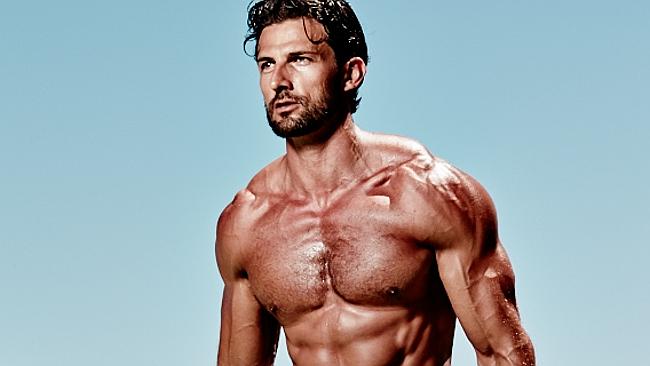
Tim Robards knows how to get ripped and healthy in a hurry. Source: News Corp Australia
LET’S face it, time is one of our most precious commodities. Even though there are so many gadgets which enable us to achieve more in a day, I for one, still find myself busier than a mosquito at a nudist colony.
We all know we should exercise but time is probably our biggest excuse. So let’s look at exactly how much time we really need and how to make the most out of that time to get healthier and reach our fitness goals.
More and more studies show that shorter bouts of exercise can be as, if not more beneficial than longer exercise sessions. Multiple sessions of five minutes a day, totalling 30 minutes daily have shown to have positive effects on your health.
However, it’s probably like the old saying: “a little something is better than nothing at all.” If you are super time poor, I would aim for a few 10 minute bouts per day. However, it’s not really enough time to break a sweat, or warm up to avoid injury. But if it means doing this or nothing at all, I would suggest the shorts bouts at a medium intensity.
Want better results? Aim for 30 minutes intense exercise, or 60 minutes if you have time for a decent warm up and cool down.

Time poor? Aim for a few 10 minute bouts of exercise per day. Source: Instagram
How intensely should I work?
Sweating is a great indicator that your body is attempting to cool down. This means that your core temperature and your metabolism have increased. If you’re failing to sweat, it can mean the room is too cold or you are extremely dehydrated. When it comes to cardio and weightlifting, there are different indicators to let you know you are stimulating your body to grow stronger and fitter:
Weights/Resistance training
A little soreness tells you that you have stressed your muscles enough to stimulate them to change and grow stronger. Without this you potentially aren’t creating any change. However, keep in mind that after exercising you shouldn’t feel like your muscles are tearing as you reach for the salt or groan like a seal in mating season as you get out of bed the next morning.
How much should you push yourself? I generally don’t suggest doing over 15 reps of an exercise unless you are recovering from an injury.
How much weight should I lift? With each set you do, you should not be able to complete more than three extra reps on that weight. So, if you choose 20kg to bench press at 12 reps, you should not be able to complete any more than 15 reps (when in super beast mode). If you can, it might mean you need to increase your weights.
Should I be feeling the deep burn that Ron Burgundy talks about? The lactic acid burn does not necessarily mean you are stressing your muscles to change for the better. Lactic acid to your muscles is like what exhaust fumes are to a car. If they build up to much, you’ll end up passing out or throwing up (or both, in some cases). You are much better off lifting a heavier weight while feeling less of a burn than high reps and lots of burning — unless you are specifically training for an event where you need to increase your lactic tolerance.
TIP: Keep breathing and don’t hold your breath when exerting. Your body can buffer some of the lactic acid through releasing carbon dioxide as you breath out.

That lactic acid burn doesn’t necessarily mean you’re stressing your muscles to change for the better. Source: Supplied
Cardio
There are different levels of cardio you can do, depending on what you are trying to achieve. If you want to get the best results from cardiovascular exercise and fat burning then go for high intensity intervals.
TIP 1: Use a heart monitor to find the heart rate from when you begin to breathe hard and your muscles start to burn. This is the point which indicates that your body is producing lactic acid and going into what is called an oxygen debt. What does this mean? It means you are stimulating cardiovascular fitness, boosting your metabolism and awakening the fat burning machine inside of you! Once you have worked out this heart rate, try and hang out in that zone for at least half your workout. This is where the intervals come into play. Start with an easy five minute warm-up, then do 30-60 second intervals, pushing into that heart rate you worked out at before. Have 30 seconds of recovery before you hit it up again. Even 20 minutes of this will have you sweating like Bronwyn Bishop catching a cab.
TIP 2: Work above a conversational pace. If you can chat and have a good old yarn you are not going to create much change in your body. If you find yourself having a good old yarn to your exercise buddy over how bad that guy was dancing to Peter Allen last night throwing his maracas around you probably aren’t working hard enough. Spare a thought to the guy with the maracas though …
Dr Tim Robards is a Chiropractor and exercise scientist (B. Med. Sc, M. Chiro) and regular news.com.au columnist. His observations and research into what people really need live a healthy life and thrive in their environment has lead him to develop The Robards Method. You can follow Tim on Instagram and Twitter.
The Truth About Exercise 48:29

Scientists are uncovering the new and surprising truths about what exercise is really doing to our bodies, and why we all respond to it differently.
- Oovvuu
- 12 Aug 2015
- TV/Science TV/Health TV/Society and Culture TV/Documentary
Originally published as Are you doing enough exercise?
